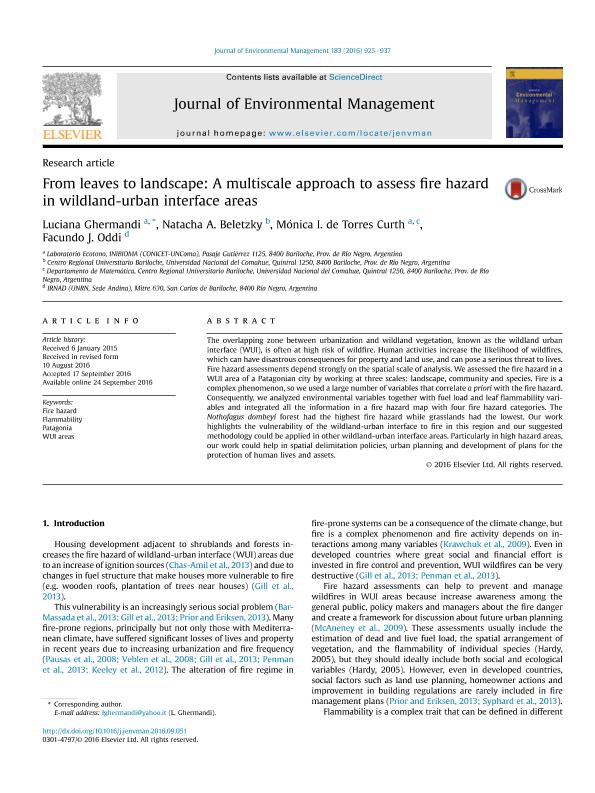Artículo
From leaves to landscape: A multiscale approach to assess fire hazard in wildland-urban interface areas
Fecha de publicación:
12/2016
Editorial:
Academic Press Ltd - Elsevier Science Ltd
Revista:
Journal of Environmental Management
ISSN:
0301-4797
Idioma:
Inglés
Tipo de recurso:
Artículo publicado
Clasificación temática:
Resumen
The overlapping zone between urbanization and wildland vegetation, known as the wildland urban interface (WUI), is often at high risk of wildfire. Human activities increase the likelihood of wildfires, which can have disastrous consequences for property and land use, and can pose a serious threat to lives. Fire hazard assessments depend strongly on the spatial scale of analysis. We assessed the fire hazard in a WUI area of a Patagonian city by working at three scales: landscape, community and species. Fire is a complex phenomenon, so we used a large number of variables that correlate a priori with the fire hazard. Consequently, we analyzed environmental variables together with fuel load and leaf flammability variables and integrated all the information in a fire hazard map with four fire hazard categories. The Nothofagus dombeyi forest had the highest fire hazard while grasslands had the lowest. Our work highlights the vulnerability of the wildland-urban interface to fire in this region and our suggested methodology could be applied in other wildland-urban interface areas. Particularly in high hazard areas, our work could help in spatial delimitation policies, urban planning and development of plans for the protection of human lives and assets.
Palabras clave:
Fire Hazard
,
Flammability
,
Patagonia
,
Wui Areas
Archivos asociados
Licencia
Identificadores
Colecciones
Articulos(INIBIOMA)
Articulos de INST. DE INVEST.EN BIODIVERSIDAD Y MEDIOAMBIENTE
Articulos de INST. DE INVEST.EN BIODIVERSIDAD Y MEDIOAMBIENTE
Citación
Ghermandi, Luciana; Beletzky, Natacha A.; de Torres Curth, Monica Irma; Oddi, Facundo José; From leaves to landscape: A multiscale approach to assess fire hazard in wildland-urban interface areas; Academic Press Ltd - Elsevier Science Ltd; Journal of Environmental Management; 183; 12-2016; 925-937
Compartir
Altmétricas




